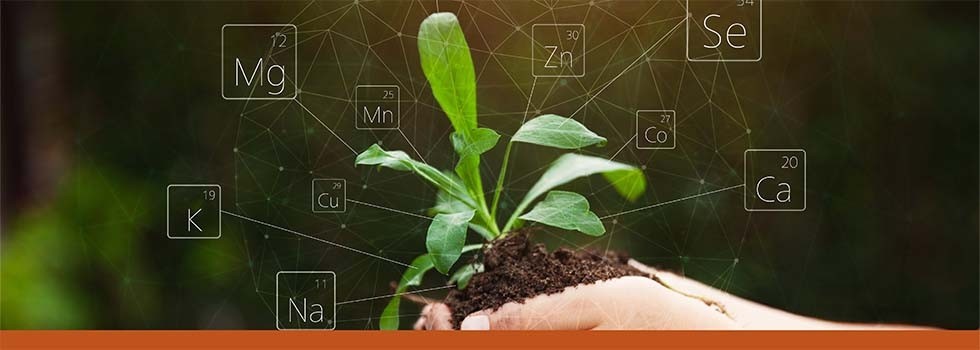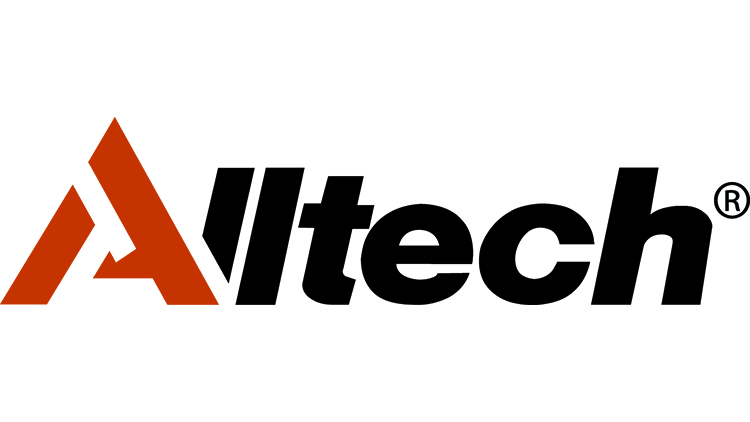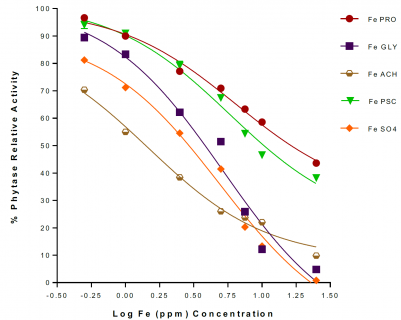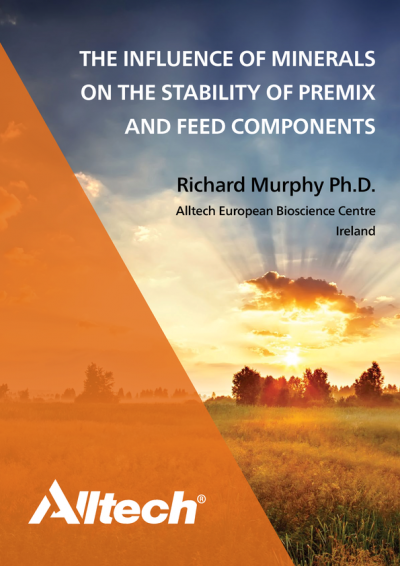Promotional Features
Chelated organic trace minerals: How can nutrient absorption be enhanced?
Richard Murphy Ph.D.
Director of Research, Alltech
Organic trace minerals — often abbreviated as OTMs — are globally recognized as a more bioavailable source of trace elements than their older and more traditional inorganic counterparts (e.g., sulfates and oxides). Because of this, more and more trace mineral products are being manufactured and classified as “organic” in the world of animal feed. However, the official terminologies provided by the Association of American Feed Control Officials (AAFCO) and the European Food Safety Authority (EFSA) on what constitutes calling a trace mineral “organic” can be ambiguous.
This often results in some trace mineral products being manufactured with similar — or sometimes inferior — efficacy compared to sulfates and oxides. As such, animal nutritionists need to consider not only whether the trace mineral source they are including is organic but whether its biological structure and degree of interaction are effective.
How are organic chelated minerals prepared and validated?
Typically, chelated minerals (or chelates) are produced by adding inorganic mineral salts to either an amino acid preparation or in the case of proteinates, a peptide mixture that has been generated by partially digesting protein with enzymes under controlled conditions. In the case of proteinates, this mixture allows the trace element to form stable chemical bonds at several different points. At a microscopic level, these multiple bonds create a ring-like structure that is highly stable from a biological perspective.
Validated assays can quantify the level of bound mineral in OTMs and are based on peer-reviewed techniques known as ATR-FTIR and PXRD. These techniques were developed by researchers at the Alltech European Bioscience Centre and complement to each other (Cantwell et al., 2017). ATR-FTIR uses a form of infra-red spectroscopy to measure the amount of bound mineral, whereas PXRD uses a form of crystallography to measure the amount of unbound mineral.
Factors driving trace mineral performance: Stability
There are several different types of OTMs available on the market (including chelates or proteinates, amino acid complexes and glycinates, to name a few). When comparing these types based on which form is best under certain conditions, many different biological factors should be considered.
One factor worth considering is the bond strength of the OTM, which is largely dictated by which organic ligand that mineral is bound to when it is manufactured. This is referred to as the stability constant.
Stability constants offer a useful measurement for evaluating trace mineral efficacy based on their bonding group. Closer examination shows that the type of bonding group — also known as a ligand — significantly influences the stability of the chelated trace mineral, with some ligands offering better outcomes than others. Although amino acids and peptides are widely used for chelation due to their ability to stably bond mineral, it’s important to remember that individual amino acids can vary considerably in the way in which they can stably interact with individual trace elements. Likewise for peptides, subtle differences in the amino acid sequence of the peptide can dramatically influence how stably the peptide interacts with mineral.
Ultimately, not only does the type of amino acid influence the stability of a given chelate, but the position of other types of amino acids in a peptide can significantly influence how the ligand and mineral interact. This is illustrated in Table 1 where it can be appreciated that most critical factors are the sequence and position of amino acids rather than the overall size. The higher the stability of an OTM, the greater its bioavailability is likely to be.
The chelation strength between the mineral and bonding group will define the OTM stability and, ultimately, play a significant role in influencing bioavailability. As such, to enhance OTM bioavailability, increasing the strength of the bond between the mineral and the bonding group used can be a very effective strategy.
Table 1: Role of amino acid sequence in chelate bond strength and stability.
Bonding group | Relative stability |
Gly-Gly-Gly (m.wt. 225Da) | 1 |
Gly-Gly-His (m.wt. 305Da) | 270 |
Gly-His-Gly (m.wt. 305Da) | 8,511 |
The influence of pH on trace mineral performance
Some OTMs have little or no capacity for stable mineral bonding when exposed to conditions with a low pH. As the mineral — along with other nutrients — moves along an animal’s gastrointestinal tract, the pH levels change according to the stage of digestion. The digesta is then subject to several physiological factors (e.g., exposure to digestive secretions that can be highly acidic), resulting in the mineral becoming unbound from its ligand and failing to be absorbed. The outcome is an unabsorbed mineral that the animal excretes as waste, which offers no nutritional benefits and increases the mineral load returned to the environment.
Using trace minerals with a high bond strength is paramount, as they have maximum pH-dependent stability, resulting in optimal bioavailability for the animal and a high nutritional value. As the mineral can withstand the changing pH levels throughout digestion, it will stay bound until it reaches the site of absorption within the intestine and will ultimately be incorporated to facilitate key biological functions, such as growth, immunity, reproduction and maintenance.
Effects of trace mineral source on feed components: Enzymes, vitamins and antioxidants
Enzyme activity
Research by Santos et al. (2014) demonstrated a highly significant relationship between phytase inhibition and trace mineral source. Both inorganic sources and a range of organic chelated sources of iron, zinc and copper were exposed to three commercial phytase preparations. Organic trace mineral chelates, provided in the form of Bioplex® — referred to as Fe PRO (proteinate) — were significantly less inhibitory than other mineral sources (Figure 1). The various organic trace mineral products displayed differential effects in their reduction of phytase activity as well as differences in their stability. These results show that the consequences of mineral-induced enzyme inhibition in premix and feed formulations can be tremendous in terms of nutritional quality and economic value.
Figure 1: Sigmoidal dose–response curves representing the effect of iron sources on P. lycii phytase activity (Santos et al., 2014).
Vitamin stability
Vitamin instability results from of oxidation-reduction reactions occurring while a feed or premix is in storage or transit. This effect can be mitigated by carefully selecting a highly stable form of trace mineral that is less likely to be reactive.
Concarr et al. (2021a) examined the stability of vitamin E through the short-term exposure of α-tocopherol acetate, a form of vitamin E, to mineral premixes containing inorganic mineral sulfates and a range of organic mineral products. The authors found that the trace mineral form significantly influenced the stability of α-tocopherol, with the premix containing organic glycinates having the highest degree of vitamin loss, at 31.9%, followed by the premix containing an organic amino acid complex, at 25.7%. On the other hand, the vitamin E stability in the premixes containing organic trace mineral chelates were not significantly different from the unexposed vitamin control group.
This research highlights the importance of carefully selecting premix components and how losses can be reduced by switching from inorganic to organic forms of trace minerals while paying close attention to the type of organic ligand used (e.g., glycinate, amino acid complex or chelate).
Antioxidant efficacy
Additional trials by the same research team assessed the impact of trace mineral form on the efficacy of common antioxidants, such as butylated hydroxytoluene (BHT). By comparing inorganic copper sulfate to different organic mineral sources (e.g., glycinates, amino acid complexes and chelates), it was demonstrated that the use of inorganic trace mineral sources in a premix can severely compromise its nutritional quality by reducing antioxidant activity by as much as thirty percent.
Similar to vitamins, the destabilization of antioxidants occurs through oxidation-reduction reactions, which effectively reduce antioxidant function. Weakly bound mineral sources are more likely to react with antioxidants and cause these reactions.
Summary
The chelation of trace minerals is a relatively simple process that yields many benefits, especially concerning higher bioavailability. Carefully considering the factors necessary for chelation — such as the type of organic ligand used (e.g., amino acids and peptides) — can help producers distinguish between the multitude of products available on the market based on their stability and efficacy.
Trace minerals with a high bond strength — and, therefore, a high stability — are more likely to be effectively absorbed by the animal and reach the target sites required for immunity, growth and reproduction, instead of dissociating and being excreted as waste, which is often what happens when supplementing minerals with a low stability. Furthermore, they are significantly less likely to react with and inhibit the activity of other feed components, such as vitamins, enzymes and antioxidants.
With more and more trace mineral sources being produced and branded as “organic,” nutritionists need to pay close attention to their choice of trace minerals — right down to their biological components — to get the most nutritional and economical value from their feed formulation.
For more information, click here to download the newly launched White Paper Review from Dr. Richard Murphy titled, "ORGANIC TRACE MINERALS: Enhancing mineral bioavailability through chelation"
DISCLAIMER: The reference to “organic chelated minerals” in this article is intended only for an organic chemistry perspective. We acknowledge that the use of the term “organic” does not mean that these products can necessarily be used in organic agricultural production systems but instead, this term comes from a pure chemistry point of view.






